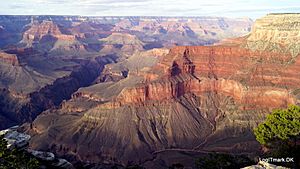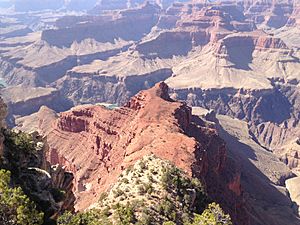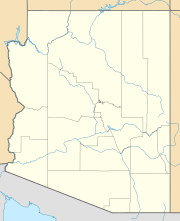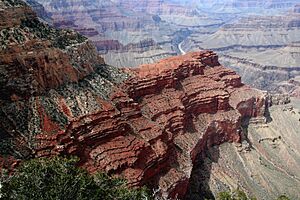The Alligator (Grand Canyon) facts for kids
Quick facts for kids The Alligator(Grand Canyon) |
|
|---|---|

The Alligator & Mohave Point
(view eastwards) |
|
| Highest point | |
| Elevation | 5,774 ft (1,760 m) |
| Prominence | 1,100 ft (340 m) |
| Isolation | ~0.50 |
| Parent peak | Mohave Point (7,974 ft) |
| Geography | |
| Location | Grand Canyon Coconino County, Arizona. U.S. |
| Parent range | Coconino Plateau Colorado Plateau |
| Topo map | USGS Grand Canyon |
| Geology | |
| Age of rock | Permian-Pennsylvanian-(prominence) down to Proterozoic |
| Type of rock | Esplanade Sandstone horizontal platform (unit 4), (complete Supai Group on platform of Redwall Limestone) and Supai Group, Redwall Limestone, (Tonto Group- 3-units) _3-Muav Limestone, _2-Bright Angel Shale, _1-Tapeats Sandstone, Vishnu Basement Rocks |
The Alligator (Grand Canyon) is a cool rock formation in the Grand Canyon. It looks like a giant alligator! This peak stands at 5,774 feet (about 1,760 meters) tall. It's a large, long hill with a flat top, called a butte.
The Alligator is connected to Mohave Point, which is part of the Grand Canyon's South Rim. It's about 1.5 miles (2.4 kilometers) northwest of Grand Canyon Village. The "head" of the alligator shape points north. Its "tail" is a lower cliff that turns towards the northwest.
This amazing landform is only about 1 mile (1.6 kilometers) from the Colorado River. The river flows west through a deep part of the canyon called Granite Gorge. The Alligator sits between two small valleys, Monument Creek and Salt Creek. These valleys are on its west and east sides. Both creeks flow south into the Colorado River.
The Alligator is made of two main types of rock. The top part is bright red-orange Supai Group rock. This rock forms both steep cliffs and gentle slopes. Below that is a large, red cliff made of Redwall Limestone. The curving "tail" of The Alligator is a flat, wide area made from this Redwall Limestone.
Understanding The Alligator's Rocks
The Alligator is mostly made of two important rock layers. The top layer is the Supai Group, which is about 1,100 feet (335 meters) thick. Below it is the Redwall Limestone, which is about 800 feet (244 meters) thick.
Both of these rock types are "cliff-formers." This means they are strong rocks that resist erosion and create steep cliffs. They also form flat areas, like shelves or platforms. The highest point of The Alligator is on a flat platform made of the toughest rock in the Supai Group, called the Esplanade Sandstone.
The curved "tail" of The Alligator is a lower platform. It sits right on top of the very strong Redwall Limestone. As the tail curves, you can see another smaller cliff and platform above the Redwall. This part is made of a different Supai rock layer called the Manakacha Formation.
Even deeper down, below the Redwall Limestone, there's another shorter cliff. This cliff is part of the Tonto Group rocks, specifically the Muav Limestone. The rest of the Tonto Group layers go all the way down to the Colorado River. At the very bottom, you'll find the ancient Vishnu Basement Rocks. These are some of the oldest rocks in the Grand Canyon!




